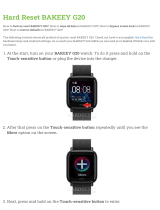
MODEL NUMBER RECOGNITION:
EXPLANATION OF MODEL NUMBER CONFIGURATION:
Most model numbers have a PREFIX and a SUFFIX. The explanation of the different Prefixes and Suffixes
is listed below. Standard fryers, with NO options and a mild steel tank, will not have any PREFIX or SUFFIX but
simply have a number (7, 14, 18 etc.)
EXPLANATION OF PREFIXES WITHIN BASIC MODEL NUMBERS:
PR = Fryer utilizing a solid state T-Stat (GO) control and melt cycle. This includes four 15 cm (6") burners
and tubes with high efficiency baffles.
PM = Fryer utilizing a built-in computer control with four 15 cm (6") burner and tubes and high
efficiency baffles.
F = Fryers supplied with a filter system built adjacent to the fryer cabinet.
RPB = Radiant Power Burner (With Automatic Ignition.)
EXPLANATION OF SUFFIXES WITHIN BASIC MODEL NUMBERS:
D = Deep foam tank area. (In the 35C+ models, D denotes SS door.)
DI = Drop-in deep fat fryer.
F = Fish fryer with low splash back.
FF = Food fryer with high splash back for submerger & drainboard.
P = Donut fryer
UFM = Under fryer filter (manual).
WKS = Computer ready with float switch and SS tank. Bottom drain. (Special for K.F.C.)
S = Fryers with stainless steel tank. This will follow the model number and precede the UFM notation.
SS = Fryers with stainless steel tank and cabinet. This will follow the model number and precede the
UFM notation.
EXPLANATION OF SUFFIXES OUTSIDE BASIC MODEL NUMBERS (OPTIONS):
The basic model number must be followed with a (-) then the suffixes. The (-) only applies to the first suffix used.
Option D = Bottom drain Option T = Drain valve safety switch
Option E = Electric T-Stat (KX-299) Option V = Universal tank
Option F = Front extensions Option W = (Fast) Computer ready
Option H = Solid state T-Stat Option ZA = (Intellifry) Computer, 14 size. Single
Option J = Electronic Ignition control Option ZB = Computer, 7 size. Single
Option K = Float switch Option Z/2A= Computer, 14 size. Dual
Option L = Basket lifts Option Z/2B= Computer, 7 size. Dual
Option R = Rear extensions
INSTALLATION:
INSTALLATION CLEARANCES:
The fryer needs clearance around it to allow for correct combustion, cleaning and for fire hazard reasons. It is
recommended that the fryers have a minimum of 15 cm of clearance from any combustible surface and have at
least 15 cm floor clearance. If the fryer is equipped with a filter, it will be necessary to allow at least 0.75 m front
clearance for the removal/installation of the filter pan/module.
VENTILATION & FIRE SAFETY SYSTEMS:
All fryers must be placed under a Hood style ventilation system. An adequate supply of fresh air shall be provided
into the room or space enclosing equipment for the units ventilation and combustion requirements. Exhaust gases
can reach high temperatures, therefore, it is important to install a fire safety system. Both the Ventilation Hood
and Fire Safety System must be installed according to local and national codes.
GAS CONNECTION:
NEVER supply the fryer with a gas that is not indicated on the data plate, located on the inside of the door. To
ensure peak performance and correct combustion Pitco Fryers must be supplied with an amount of Fuel Gas
sufficient to meet the rating requirements shown on the data plate, found on the inside of the door. All gas
connections must be made by a Certified Gas Service Technician.
FUEL LINE TESTING:
Since the internal gas valve of the Pitco Fryer is rated at 50 mbar maximum pressure, it is imperative that no
testing be done at a pressure greater than this. If it is necessary to test at a pressure greater than this, the fryer
should be isolated from the gas line so that damage to the gas valve does not occur.
3



















